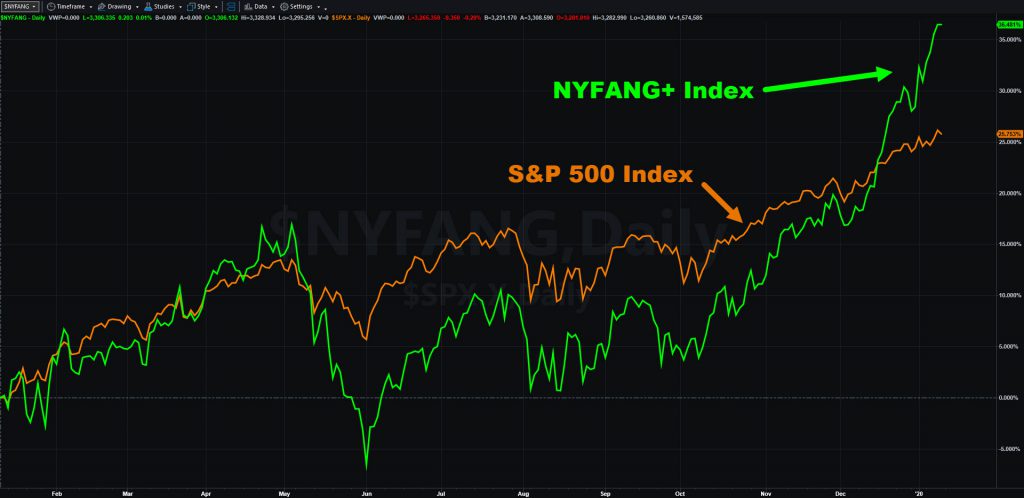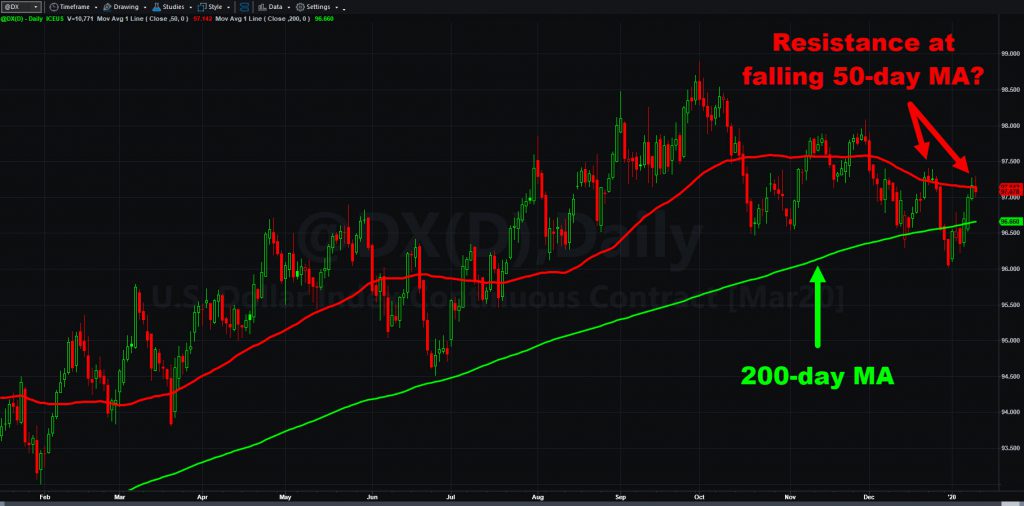Stocks began the new decade on a strong note as investors stuck with technology despite saber-rattling in the Middle East.
The S&P 500 rose 0.9 percent between Friday, January 3, and Friday, January 10. It was the first full week of 2020 and the 12th positive week in the last 14. The Dow Jones Industrial Average also crossed the symbolically important 29,000 level for the first time.
It could have been a lot worse. Major indexes dropped 1.5 percent on Tuesday night after Iran fired more than 10 missiles at U.S. bases in Iraq. However they quickly rebounded once traders realized the action was a symbolic response to the killing of General Qasem Soleimani the previous week.
Technology dominated the gains again as investors flocked to a widening array of companies and groups. The NYSE FANG+ Index ($NYFANG) shot to new highs. Salesforce.com (CRM) led a breakout in software companies.

Chinese Internet firms like Alibaba (BABA), Baidu (BIDU) and JD.com (JD) advanced as investors return to the world’s No. 2 economy. It could remain in focus this week with President Trump and Vice Premier Liu He set to sign a trade deal at the White House.
Tesla and Luckin Coffee
Speaking of the Asian giant, some of the most noteworthy movers last week had a Chinese angle. Electric-car maker Tesla (TSLA) continued its blistering rally as it launched a new Model Y in China. Elon Musk’s company now has a bigger market capitalization than 85 percent of the S&P 500, despite not being in the index.
Luckin Coffee (LK) is another upstart with heavy volume. The Xiamen-based company ripped 17 percent to a new all-time high last week, and has more than doubled from its May 16 initial public offering.
Already famous for accepting orders exclusively via mobile app, LK took it to the next level last week by rolling out smart devices for vending locations and the home. Is it like Starbucks (SBUX), but with a double-shot of innovation and growth?
Another foreign tech stock, Buenos Aires-based Mercadolibre (MELI), rallied 10 percent for no obvious reason. That made it the biggest gainer in the Nasdaq-100 last week.
Global Backdrop Improving?
The shift to global equities comes at a time when conditions have improved overseas:
- On Monday, the Euro Zone’s Sentix confidence survey rose more than expected to its highest level in more than a year.
- On Tuesday, Taiwanese trade increased much more than forecast. Chinese foreign-exchange reserves also rose more than expected as Beijing apparently stopped intervening to weaken the yuan.
- On Thursday the World Bank predicted a rebound in global growth as investment recovers. Bloomberg also reported a surge of issuance in the European bond market.
Meanwhile in the U.S., things weren’t as impressive. December’s non-farm payrolls report missed estimates and wages lagged projections. Don’t forget that the Federal Reserve has pledged to keep rates low until inflation gets persistently above 2 percent. Last week’s data didn’t just keep the central bank on hold. It may have pushed it toward more easing.

Consider this data from the CME’s FedWatch Tool: Before Friday’s weak jobs report, traders saw a 41 percent chance that rates would remain unchanged through December. After the miss, only 31 percent held that view.
That could raise questions about the U.S. dollar index, which continues to consolidate below its 50-day moving average. Downside in the greenback could also help sentiment toward global stocks, along with precious metals. Low interest rates can lift high-multiple growth stocks as well.
Bitcoin’s Big Move
Bitcoin (BTCUSD) also rallied 11 percent — its biggest weekly gain since August. The cryptocurrency has been trying to fight its way higher after forming a rounded bottom in late 2019. It may have some catalysts this year, including the North American Bitcoin Conference and new options contracts this week.
Crude oil, on the other hand, had its biggest weekly drop since mid-July after tensions calmed between the U.S. and Iran. That handed energy stocks their first drop in the last six weeks.
Corporate earnings season begins this week, led by the banks.
JPMorgan Chase (JPM), Wells Fargo (WFC) and Delta Airlines (DAL) get the ball rolling this morning. Inflation numbers are also due. Chinese trade numbers in the evening may have an impact the next session.
Wednesday features Bank of America (BAC), Goldman Sachs (GS) and UnitedHealth (UNH), along with producer prices and oil inventories. The North American Bitcoin Conference also begins in Miami.
Morgan Stanley (MS) and Taiwan Semiconductor (TSM) follow on Thursday. Jobless claims and NAHB’s housing-market index. Big Chinese reports, including gross domestic product, industrial production and retail sales are also due in the evening.
Housing starts, building permits, consumer sentiment and industrial production come on Friday. The housing data could be important — especially when you consider the low interest rates and lack of inventory on the market.
As a reminder, the following week is shortened by Martin Luther King day on January 20.


























